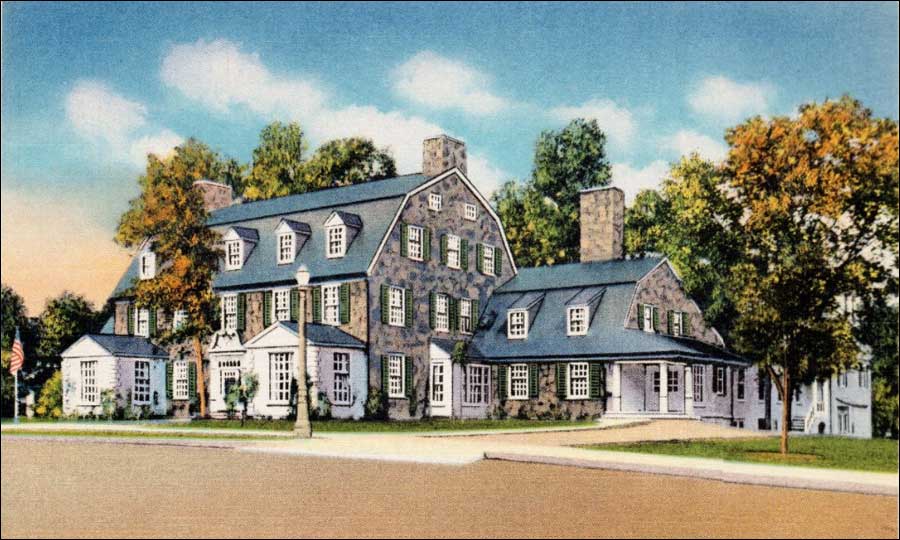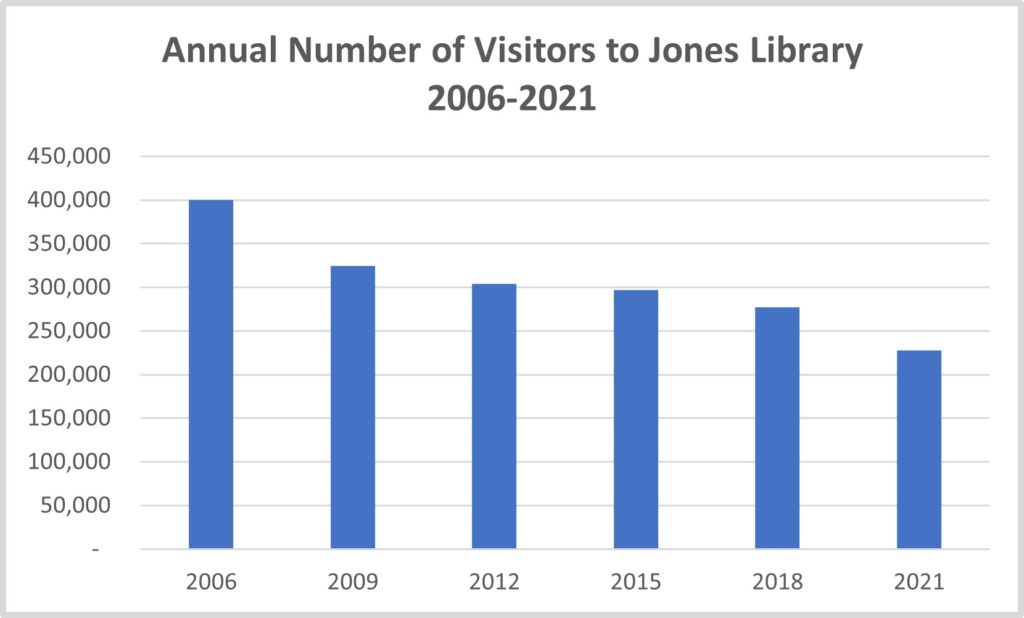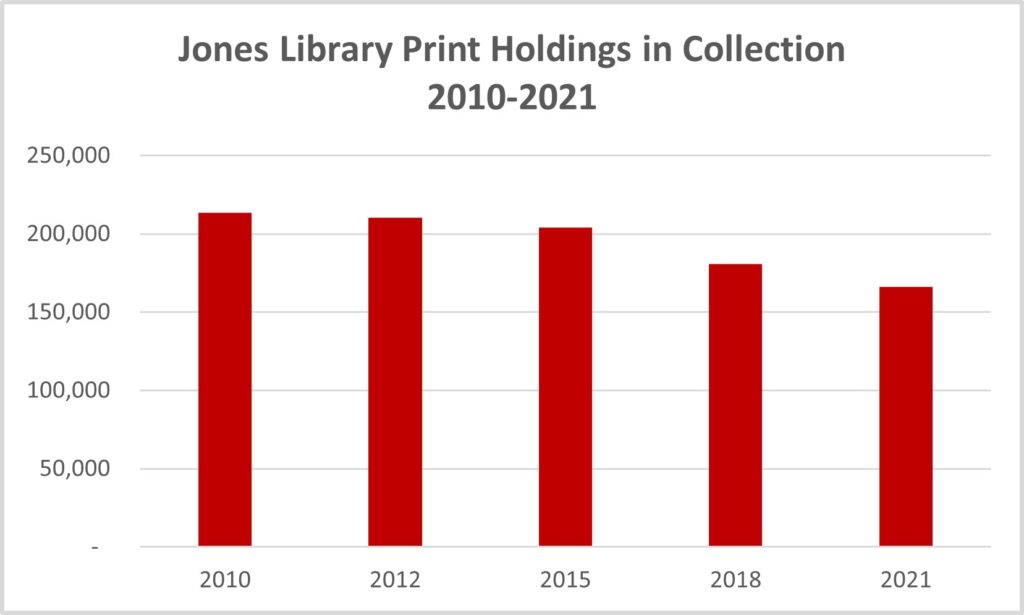Issues & Analyses: Public Libraries Are Shedding Books And Losing Visitors – So Why Do We Make Them Bigger?

Photo: Digital Commonwealth (CC BY-NC-ND)
Even before the pandemic, public libraries across the country began seeing fewer visitors. In a May 2021 article, Publishers Weekly reported, “In the U.S. there has been a fall of 31% in public library building use over eight years, up to 2018.”
During the same period, libraries were reducing the number of books in their collections in favor of audio, video, and especially online digital formats. Digital materials require no physical space and can be retrieved by patrons in the comfort of their own homes.
It is reasonable to expect that libraries might respond to these diminishing space needs by avoiding costly building expansion projects. However, across the Commonwealth we have seen that this is frequently not the case, as expensive and often divisive library enlargement efforts have launched in Holyoke, Greenfield, Woburn, Gloucester, East Bridgewater, and now Amherst, to name a few.
Amherst’s $36.3 million Jones Library Renovation-Expansion Project is particularly aggressive in its quest for space. According to statistics compiled by the Massachusetts Board of Library Commissioners (MBLC), Amherst has the 39th largest library population in the state while the Jones is currently the 22nd largest library. Not reflected is that fact that about half of Amherst’s residents are college students with institutional libraries of their own.
The Jones Library Building Project will add close to 15,000 square feet and will position the facility as the ninth largest public library in Massachusetts.
Among measures used to justify the enlargement, expansion proponents projected that the Jones Library needs to support a service population of 47,000, 35% of whom are non-residents (and incidentally do not support the project’s cost with property taxes). A look at MBLC historical data on Jones Library visitors tells a somewhat different story.
Back in 2000 the Jones Library counted 373,075 visitors for the year. The number of annual visitors grew and peaked at 400,000 in 2006, and then began a steady decline. By 2018 visitors had fallen to 276,925, and by 2020, were down to 227,971, representing only 57% of visitor activity experienced during the 2006 peak.

Traditionally the primary attraction for library visitors has been books. In 2015 the Jones Library conducted a survey which asked respondents to indicate what library services they used. 87% reported using the General Collection, followed by 69% seeking Help from a librarian, and 68% using Interlibrary loan. All other services were used by fewer than 50% of those responding.
Respondents were also asked to rate the importance of different types of items in the General Collection. 80% rated Books as “Most Important.” Of the remaining formats – Videos, Audiobooks, Periodicals, and Ebooks – none were rated “Most Important” by more than 8% of responses.
Perhaps the Jones Library’s recent practice of reducing the number of books in its collection has contributed to the decline in attendance. The MBLC reports that in 2010 the Jones Library had Print Holdings of 213,388 items. Thousands of hardcopy books were eliminated over the next 12 years until by last year the Print Holdings count had fallen to 166,117.

With the number of visitors in steady decline, and a substantial amount of shelf space freed up through the elimination of books, does Amherst really need to build the ninth largest public library in Massachusetts?
Of course, when it comes to funding a building project, size matters. The Jones Library Renovation-Expansion is part of Amherst’s Four Building Project Plan, along with a new elementary school, fire station and DPW headquarters. Over the past months the construction cost estimate for the four projects has escalated from $90 million to $130 million and has yet to be pinned down.
Amherst decisionmakers may be faced with the painful choice of dropping one of the building projects or asking the voters to pass a tax override which is likely to be financially crippling for many.
This begs the question: of a library renovation-expansion, a new elementary school, a replacement of the 95-year-old Central Fire Station and a replacement of the 100-year-old Department of Public Works facility, which are luxuries, and which are necessities?

Jeff’s question is somewhat rhetorical, but the new circumstances raised by escalating costs make it reasonable to ask even now. And even though many of us have taken sides in the matter of the library size for several years there are ways of thinking about this now that could bring the town together – if it was inclined to be brought together.
It is pretty clear that the library has aspirations to serve Amherst as a community center, with its emphasis moving from collections to programs and events. This has never been advanced as part of the campaign to enlarge the Jones but it is occurring at the same time that Leisure Services and Supplemental Education (LSSE) has been abandoned in favor of Recreation.
The Town’s approach to all this has always been incoherent, with departments, private organizations and religious institutions duplicating their services and competing with one another. A thoughtful inventory of our civic spaces and a rationalization of the programmatic offerings of the Jones, the Town Recreation Department, the Senior Center, Amherst Neighbors,, not to mention the branch libraries and the three of the five colleges located here. With such an inventory we would discover, for the first time, what our needs are, and we could begin to discuss how to address them.
Surely the Library Trustees would be a party to such a discussion but they would be only one such party. We could build a somewhat enlarged Jones Library based upon an understanding of these needs rather than the fanciful “statistics” which have thus far been the basis of the Jones campaign.. Size, scale, and streetscape could once again be at the center of a campaign for a newly conceived Jones Library.
Thank you. I have wondered what evidence there is that supports library use growth as opposed to the decline which is actually happening. I think that this whole library expansion idea is based on the “If you build it they will come” hope. In the U.S. there has been a fall of 31% in public library building use over eight years, up to 2018,” from Publishers Weekly. https://www.publishersweekly.com/pw/by-topic/industry-news/libraries/article/86256-report-urges-library-leaders-to-address-decline-in-public-library-usage.html
It is a fanciful belief that if we build a huge library that Amherst residents will flock to it in large numbers while more and more people are reading digital books every year and young people are especially invested in digital content. This project is built on a dream not facts.
Thank you, Jeff Lee, and Michael Greenbaum, for persisting in writing about why the current library plan is a monumental mistake.